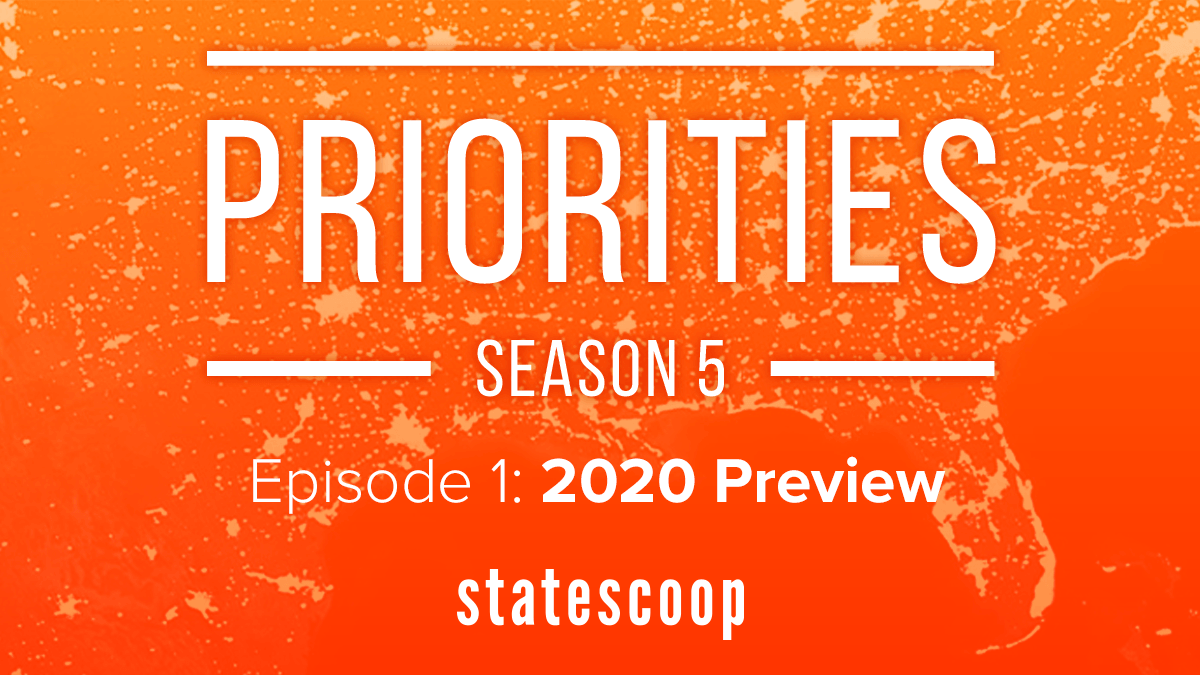
What’s next for state and local government IT in 2020?
Major events are primed to unfold in 2020 and many of them will affect and be affected by what happens in the state governments. In the latest episode of StateScoop’s Priorities podcast, I (Colin Wood, StateScoop’s managing editor) talk to three people who are paying close attention to the state and local government technology landscape to understand what everyone should expect in the coming months.
StateScoop’s tech editor, Benjamin Freed, outlines his thoughts on the current trajectory of election security efforts in this presidential election year, an issue with an elevated profile nationally in recent years and is sure to be increasingly discussed as November approaches.
“This year is going to be a major test of all of the new systems and technologies and procedures that have been put into place since 2016,” Freed says on the podcast.
StateScoop’s coverage of mobile voting apps, like Voatz, will continue this year, as will coverage of cybersecurity generally. Most recently, the University of Southern California announced it’s launching a 50-state series of election cybersecurity conferences, aimed at helping election officials, campaign workers and elected officials brush up on their online habits by Election Day.
If elections alone weren’t enough to keep everyone busy, Meredith Ward and Amy Glasscock, both with the National Association of State Chief Information Officers, join the podcast to say that artificial intelligence, privacy issues and increased collaboration between state and local governments on improving cybersecurity are another three main issues expected to dominate schedules this year.
“I’ve heard a lot of people say that 2019 was the year of ransomware,” Ward says. “I think that that will likely continue and that states offering additional services or having increased collaboration with local government will increase in 2020.”
Increased interest in encouraging and funding collaboration between states and their local governments is also one of NASCIO’s federal advocacy priorities for 2020, as the group backs federal legislation that would give states new funding for cybersecurity.
Within the CIO’s office, IT leaders are continuing to search for ways to “do more with less” as the role’s unofficial mantra supposes. In the podcast, Glasscock points to NASCIO’s recent survey results, which show that fewer CIOs are naming the “internet of things” when asked which technologies they expect to have the most influence over the next three to five years.
“We’ve seen that trend continue, so our most recent survey in 2019, AI was again No. 1 with 65 percent and it just seems like people are talking less about IoT these days and it just got 20 percent,” Glasscock says. “[Robotic process automation] and chatbots, those are really the first things that states might use in the AI world and they’re sort of the low-hanging fruit, so if you can develop a chatbot, and a lot of states have done that — they usually have clever names — to answer some of those typical questions you get from citizens or recent passwords and things like that, it really can save a lot of time.”
Privacy is also expected to be a major issue this year, she says. Following the European Union’s General Data Protection Regulation and California’s landmark privacy act, five other states — Illinois, Nebraska, New Hampshire, Washington and Virginia — have introduced comprehensive privacy bills.
The number of states with chief privacy officers has risen, too, from five such dedicated state-level positions in 2014 to 13 today, Glasscock said.
“Not all of these pieces of legislation apply to state government,” Ward says. “Obviously a lot of them are geared toward citizens, private sector and the language is different in these handful of bills, but in these discussions we’ve had with CIOs, they don’t want to be caught however many years down the road, if legislation now impacts them on a greater level, they really don’t want to be caught unprepared.”
On this episode:
- Colin Wood, managing editor, StateScoop
- Benjamin Freed, tech editor, StateScoop
- Amy Glasscock, senior policy analyst, NASCIO
- Meredith Ward, director of policy and research, NASCIO
Things to listen for:
- Election security discussions are heating up and mobile voting apps, while still on the periphery, are worth watching.
- StateScoop will be releasing content packages this year, each themed around a different topic, such as “smart cities” or cybersecurity. The first content package, to be released in February, is about user experience.
- Chief privacy officers are becoming a more common role within state government, now with 13 such dedicated roles in states.
- NASCIO is set to release new research later this year as it prepares for its midyear conference in May.
- StateScoop isn’t the only one with a podcast about state government IT. NASCIO also has a new podcast, called Voices.
Produced in partnership with the National Association of State Chief Information Officers, Priorities dives deep into each of the top 10 priorities of state CIOs outlined in NASCIO’s annual list.
Listen to archived episodes of Priorities from Season 5 (2020), Season 4 (2019), Season 3 (2018), Season 2 (2017) and Season 1 (2016). Catch all of StateScoop’s podcasts on Soundcloud, Apple Podcasts, Spotify, Google Play, Stitcher or Alexa’s TuneIn.


